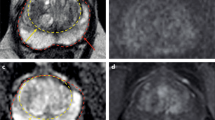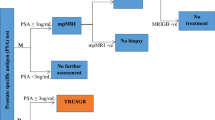Abstract
Background
Multiparametric magnetic resonance imaging (MP-MRI) targeted biopsy has been shown to identify more clinically-significant cancers and reduce the detection of clinically-insignificant disease when compared to systematic biopsy; however, the wide-spread accessibility of MP-MRI is limited. A potential strategy for reducing the cost, study time, and contrast-associated risks associated with MP-MRI is elimination of the dynamic contrast-enhanced (DCE) sequence, relying instead on biparametric MRI (BP-MRI). BP-MRI has been shown to have a diagnostic accuracy and cancer detection rate that are equivalent to those of MP-MRI.
Methods
We modeled the potential cost of BP-MRI compared to MP-MRI to determine what cost savings would occur if DCE was eliminated from these studies.
Results
When controlled for a 45 min time window that allows for one full MP-MRI or three full BP-MRI studies, the BP-MRI 45 min gross profit is $1531.32. This is an increase in gross profit of $892.58 for the 45 min time window or $10,710.98 in a 9-h business day when performing BP-MRI compared to MP-MRI for prostate cancer detection.
Conclusions
BP-MRI has the potential to result in substantial cost benefit and increased access to MRI in the diagnostic workflow and risk-stratification of men being evaluated for prostate cancer when compared to conventional MP-MRI.
Key points
• Multiparametric magnetic resonance imaging (MP-MRI) has been shown to identify more clinically-significant cancers and reduce the detection of clinically-insignificant disease.
• Biparametric magnetic resonance imaging (BP-MRI) has diagnostic accuracy and cancer detection rates that are equivalent to those of MP-MRI.
• BP-MRI reduces cost, study time, and contrast-associated risk by eliminating the dynamic contrast-enhanced (DCE) sequence.
• BP-MRI has the potential to increase access to advanced imaging for men being evaluated for prostate cancer.
This is a preview of subscription content, access via your institution
Access options
Subscribe to this journal
Receive 4 print issues and online access
$259.00 per year
only $64.75 per issue
Buy this article
- Purchase on Springer Link
- Instant access to full article PDF
Prices may be subject to local taxes which are calculated during checkout
Similar content being viewed by others
References
Siegel RL, Miller KD, Jemal A. Cancer statistics, 2018. Cancer J Clin. 2018;68:7–30.
National Cancer Institute. Cancer Stat Facts: Prostate Cancer https://seer.cancer.gov/statfacts/html/prost.html. Accessed July 10, 2018.
U. S. Preventive Services Task Force, Grossman DC, Curry SJ, Owens DK, Bibbins-Domingo K, Caughey AB, et al. Screening for prostate cancer: US Preventive Services Task Force Recommendation Statement. JAMA. 2018;319:1901–13.
Fenton JJ, Weyrich MS, Durbin S, Liu Y, Bang H, Melnikow J. Prostate-specific antigen-based screening for prostate cancer: evidence report and systematic review for the US Preventive Services Task Force. JAMA. 2018;319:1914–31.
Ahmed HU, El-Shater Bosaily A, Brown LC, Gabe R, Kaplan R, Parmar MK, et al. Diagnostic accuracy of multi-parametric MRI and TRUS biopsy in prostate cancer (PROMIS): a paired validating confirmatory study. Lancet. 2017;389:815–22.
Schoots IG, Roobol MJ, Nieboer D, Bangma CH, Steyerberg EW, Hunink MG. Magnetic resonance imaging-targeted biopsy may enhance the diagnostic accuracy of significant prostate cancer detection compared to standard transrectal ultrasound-guided biopsy: a systematic review and meta-analysis. Eur Urol. 2015;68:438–50.
Siddiqui MM, Rais-Bahrami S, Turkbey B, George AK, Rothwax J, Shakir N, et al. Comparison of MR/ultrasound fusion-guided biopsy with ultrasound-guided biopsy for the diagnosis of prostate cancer. JAMA. 2015;313:390–7.
Yarlagadda VK, Lai WS, Gordetsky JB, Porter KK, Nix JW, Thomas JV, et al. MRI/US fusion-guided prostate biopsy allows for equivalent cancer detection with significantly fewer needle cores in biopsy-naive men. Diagn Interv Radiol. 2018;24:115–20.
Kasivisvanathan V, Rannikko AS, Borghi M, Panebianco V, Mynderse LA, Vaarala MH, et al. MRI-targeted or standard biopsy for prostate-cancer diagnosis. N Engl J Med. 2018;378:1767–77.
Sherrer RL, Lai WS, Thomas JV, Nix JW, Rais-Bahrami S. Incidental findings on multiparametric MRI performed for evaluation of prostate cancer. Abdom Radiol (NY) 2018;43:696–701.
Leake JL, Hardman R, Ojili V, Thompson I, Shanbhogue A, Hernandez J, et al. Prostate MRI: access to and current practice of prostate MRI in the United States. J Am Coll Radiol. 2014;11:156–60.
Kim S, Vickers AJ, Hu JC. Challenges in adopting level 1 evidence for multiparametric magnetic resonance imaging as a biomarker for prostate cancer screening. JAMA Oncol. 2018;4:1663–4.
Weinreb JC, Barentsz JO, Choyke PL, Cornud F, Haider MA, Macura KJ, et al. PI-RADS prostate imaging—reporting and data system: 2015, Version 2. Eur Urol. 2016;69:16–40.
Fascelli M, Rais-Bahrami S, Sankineni S, Brown AM, George AK, Ho R, et al. Combined biparametric prostate magnetic resonance imaging and prostate-specific antigen in the detection of prostate cancer: a validation study in a biopsy-naive patient population. Urology. 2016;88:125–34.
Kuhl CK, Bruhn R, Kramer N, Nebelung S, Heidenreich A, Schrading S. Abbreviated biparametric prostate MR imaging in men with elevated prostate-specific antigen. Radiology. 2017;285:493–505.
Lee DH, Nam JK, Lee SS, Han JY, Lee JW, Chung MK, et al. Comparison of multiparametric and biparametric MRI in first round cognitive targeted prostate biopsy in patients with PSA levels under 10 ng/mL. Yonsei Med J. 2017;58:994–9.
Rais-Bahrami S, Siddiqui MM, Vourganti S, Turkbey B, Rastinehad AR, Stamatakis L, et al. Diagnostic value of biparametric magnetic resonance imaging (MRI) as an adjunct to prostate-specific antigen (PSA)-based detection of prostate cancer in men without prior biopsies. BJU Int 2015;115:381–8.
Sheridan AD, Nath SK, Syed JS, Aneja S, Sprenkle PC, Weinreb JC, et al. Risk of clinically significant prostate cancer associated with prostate imaging reporting and data system category 3 (Equivocal) lesions identified on multiparametric prostate MRI. Am J Roentgenol. 2017;210:347–57.
PayScale. Diagnostic radiologist salary. https://www.payscale.com/research/US/Job=Diagnostic_Radiologist/Salary. Accessed July 12, 2018.
Bureau of Labor Statistics U.S. Department of Labor. Occupational outlook handbook, radiologic and MRI technologists https://www.bls.gov/ooh/healthcare/radiologic-technologists.htm. Accessed July 12, 2018.
Siddiqui MM, George AK, Rubin R, Rais-Bahrami S, Parnes HL, Merino MJ, et al. Efficiency of prostate cancer diagnosis by MR/ultrasound fusion-guided biopsy vs. standard extended-sextant biopsy for MR-visible lesions. J Natl Cancer Inst. 2016;108:9.
Cerantola Y, Dragomir A, Tanguay S, Bladou F, Aprikian A, Kassouf W. Cost-effectiveness of multiparametric magnetic resonance imaging and targeted biopsy in diagnosing prostate cancer. Urol Oncol. 2016;34:119 e1–9.
de Rooij M, Crienen S, Witjes JA, Barentsz JO, Rovers MM, Grutters JP. Cost-effectiveness of magnetic resonance (MR) imaging and MR-guided targeted biopsy versus systematic transrectal ultrasound-guided biopsy in diagnosing prostate cancer: a modelling study from a health care perspective. Eur Urol. 2014;66:430–6.
Faria R, Soares MO, Spackman E, Ahmed HU, Brown LC, Kaplan R, et al. Optimising the diagnosis of prostate cancer in the era of multiparametric magnetic resonance imaging: a cost-effectiveness analysis based on the Prostate MR Imaging Study (PROMIS). Eur Urol. 2018;73:23–30.
Jung JW, Kang HR, Kim MH, Lee W, Min KU, Han MH, et al. Immediate hypersensitivity reaction to gadolinium-based MR contrast media. Radiology. 2012;264:414–22.
Acknowledgements
The authors gratefully acknowledge the assistance and support of Verlon Salley, Jeff McGough, Kecia Turner and Kathy Dabbs from the University of Alabama at Birmingham Department of Radiology.
Author information
Authors and Affiliations
Corresponding author
Ethics declarations
Conflict of interest
Soroush Rais-Bahrami serves as a consultant to Philips/InVivo Corp, Genomic Health Inc, and Blue Earth Diagnostics. The remaining authors declare that they have no conflict of interest.
Additional information
Publisher’s note: Springer Nature remains neutral with regard to jurisdictional claims in published maps and institutional affiliations.
Rights and permissions
About this article
Cite this article
Porter, K.K., King, A., Galgano, S.J. et al. Financial implications of biparametric prostate MRI. Prostate Cancer Prostatic Dis 23, 88–93 (2020). https://doi.org/10.1038/s41391-019-0158-x
Received:
Revised:
Accepted:
Published:
Issue Date:
DOI: https://doi.org/10.1038/s41391-019-0158-x
This article is cited by
-
A preoperative magnetic resonance imaging-based model to predict biochemical failure after radical prostatectomy
Scientific Reports (2023)
-
Concordance between biparametric MRI, transperineal targeted plus systematic MRI-ultrasound fusion prostate biopsy, and radical prostatectomy pathology
Scientific Reports (2022)
-
RETRACTED ARTICLE: Biparametric MR signal characteristics can predict histopathological measures of prostate cancer
European Radiology (2022)
-
Analysis of risk factors for determining the need for prostate biopsy in patients with negative MRI
Scientific Reports (2021)
-
All change in the prostate cancer diagnostic pathway
Nature Reviews Clinical Oncology (2020)



